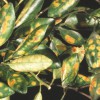 Since mineral nutrition is a major factor in maximizing yield of high quality fruit, understanding the functions of mineral elements, diagnosing nutrient deficiencies, and providing needed fertilizers are essential. This publication describes and discusses molybdenum (Mo) and nickel (Ni) deficiencies, functions, and recommended practices to alleviate nutritional problems.This 3-page fact sheet was written by Mongi Zekri and Tom Obreza , and published by the UF Department of Soil and Water Science, March 2014.
Since mineral nutrition is a major factor in maximizing yield of high quality fruit, understanding the functions of mineral elements, diagnosing nutrient deficiencies, and providing needed fertilizers are essential. This publication describes and discusses molybdenum (Mo) and nickel (Ni) deficiencies, functions, and recommended practices to alleviate nutritional problems.This 3-page fact sheet was written by Mongi Zekri and Tom Obreza , and published by the UF Department of Soil and Water Science, March 2014.
http://edis.ifas.ufl.edu/ss618
Tag: Citrus Tree Nutrient series
Iron (Fe) and Copper (Cu) for Citrus Trees
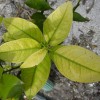 Since mineral nutrition is a major factor in maximizing yield of high-quality fruit, understanding the functions of mineral elements, diagnosing nutrient deficiencies, and providing needed fertilizers are essential. This publication describes and discusses iron (Fe) and copper (Cu) deficiencies, functions, and recommended practices to alleviate nutritional problems. This 7-page fact sheet was written by Mongi Zekri and Tom Obreza, and published by the UF Department of Soil and Water Science, March 2014.
Since mineral nutrition is a major factor in maximizing yield of high-quality fruit, understanding the functions of mineral elements, diagnosing nutrient deficiencies, and providing needed fertilizers are essential. This publication describes and discusses iron (Fe) and copper (Cu) deficiencies, functions, and recommended practices to alleviate nutritional problems. This 7-page fact sheet was written by Mongi Zekri and Tom Obreza, and published by the UF Department of Soil and Water Science, March 2014.
http://edis.ifas.ufl.edu/ss617
Manganese (Mn) and Zinc (Zn) for Citrus Trees
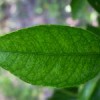 Since mineral nutrition is a major factor in maximizing yield of high-quality fruit, understanding the functions of mineral elements, diagnosing nutrient deficiencies, and providing needed fertilizers are essential. This publication describes and discusses manganese (Mn) and zinc (Zn) deficiencies, functions, and recommended practices to alleviate nutritional problems. This 5-page fact sheet was written by Mongi Zekri and Tom Obreza , and published by the UF Department of Soil and Water Science, March 2014.
Since mineral nutrition is a major factor in maximizing yield of high-quality fruit, understanding the functions of mineral elements, diagnosing nutrient deficiencies, and providing needed fertilizers are essential. This publication describes and discusses manganese (Mn) and zinc (Zn) deficiencies, functions, and recommended practices to alleviate nutritional problems. This 5-page fact sheet was written by Mongi Zekri and Tom Obreza , and published by the UF Department of Soil and Water Science, March 2014.
http://edis.ifas.ufl.edu/ss616
Calcium (Ca) and Sulfur (S) for Citrus Trees
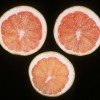 Calcium and sulfur are sometimes called secondary nutrients. This term does not mean that these nutrients play a secondary role in citrus plant growth and development. Ca and S are as essential as N, P, K, Mg, and other nutrients for healthy plant growth. An inadequate supply of Ca and/or S can be a major constraint to crop production and quality. This 5-page fact sheet was written by Mongi Zekri and Tom Obreza, and published by the UF Department of Soil and Water Science, July 2013.
Calcium and sulfur are sometimes called secondary nutrients. This term does not mean that these nutrients play a secondary role in citrus plant growth and development. Ca and S are as essential as N, P, K, Mg, and other nutrients for healthy plant growth. An inadequate supply of Ca and/or S can be a major constraint to crop production and quality. This 5-page fact sheet was written by Mongi Zekri and Tom Obreza, and published by the UF Department of Soil and Water Science, July 2013.
http://edis.ifas.ufl.edu/ss584
Potassium (K) for Citrus Trees
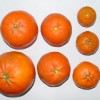 Citrus fruits remove large amounts of K compared to other nutrients. Potassium moves from leaves to fruit and seeds as they develop. Potassium is necessary for several basic physiological functions such as the formation of sugars and starch, synthesis of proteins, normal cell division and growth, and neutralization of organic acids. Potassium is important in fruit formation and enhances fruit size, flavor, and color. This nutrient also helps to reduce the influence that adverse weather conditions (such as drought, cold, and flooding) have on citrus trees. This 4-page fact sheet was written by Mongi Zekri and Tom Obreza, and published by the UF Department of Soil and Water Science, July 2013.
Citrus fruits remove large amounts of K compared to other nutrients. Potassium moves from leaves to fruit and seeds as they develop. Potassium is necessary for several basic physiological functions such as the formation of sugars and starch, synthesis of proteins, normal cell division and growth, and neutralization of organic acids. Potassium is important in fruit formation and enhances fruit size, flavor, and color. This nutrient also helps to reduce the influence that adverse weather conditions (such as drought, cold, and flooding) have on citrus trees. This 4-page fact sheet was written by Mongi Zekri and Tom Obreza, and published by the UF Department of Soil and Water Science, July 2013.
http://edis.ifas.ufl.edu/ss583
Phosphorus (P) for Citrus Trees
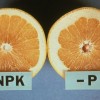 Phosphorus deficiency is not common in Florida citrus groves. If it does occur, it is more difficult to diagnose than nitrogen (N) deficiency or other nutrient element deficiencies. Growth is reduced when P supply is too low. Phosphorus is highly mobile in plants, so when it is deficient, it may move from old leaves to young leaves and other actively growing areas where energy is needed to form seeds and fruit. This 4-page fact sheet was written by Mongi Zekri and Tom Obreza, and published by the UF Department of Soil and Water Science, July 2013.
Phosphorus deficiency is not common in Florida citrus groves. If it does occur, it is more difficult to diagnose than nitrogen (N) deficiency or other nutrient element deficiencies. Growth is reduced when P supply is too low. Phosphorus is highly mobile in plants, so when it is deficient, it may move from old leaves to young leaves and other actively growing areas where energy is needed to form seeds and fruit. This 4-page fact sheet was written by Mongi Zekri and Tom Obreza, and published by the UF Department of Soil and Water Science, July 2013.
http://edis.ifas.ufl.edu/ss581
Magnesium (Mg) for Citrus Trees
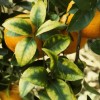 Magnesium deficiency has been a major problem in citrus production. In Florida, Mg deficiency is commonly referred to as “bronzing.” Trees with inadequate Mg may have no symptoms in the spring growth flush, but leaf symptoms develop as the leaves age and the fruit expand and mature in the summer and fall. Magnesium deficiency symptoms occur on mature leaves following the removal of Mg to satisfy fruit requirements. This 4-page fact sheet was written by Mongi Zekri and Tom Obreza, and published by the UF Department of Soil and Water Science, July 2013.
Magnesium deficiency has been a major problem in citrus production. In Florida, Mg deficiency is commonly referred to as “bronzing.” Trees with inadequate Mg may have no symptoms in the spring growth flush, but leaf symptoms develop as the leaves age and the fruit expand and mature in the summer and fall. Magnesium deficiency symptoms occur on mature leaves following the removal of Mg to satisfy fruit requirements. This 4-page fact sheet was written by Mongi Zekri and Tom Obreza, and published by the UF Department of Soil and Water Science, July 2013.
http://edis.ifas.ufl.edu/ss582
Nitrogen (N) for Citrus Trees
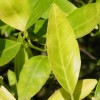 Nitrogen is the key component in mineral fertilizers applied to citrus groves. N has more influence on tree growth, appearance, and fruit production/quality than any other mineral element. Nitrogen affects the absorption and distribution of practically all other elements, and it is particularly important to the tree during flowering and fruit set. This 3-page fact sheet was written by Mongi Zekri and Tom Obreza, and published by the UF Department of Soil and Water Science, July 2013.
Nitrogen is the key component in mineral fertilizers applied to citrus groves. N has more influence on tree growth, appearance, and fruit production/quality than any other mineral element. Nitrogen affects the absorption and distribution of practically all other elements, and it is particularly important to the tree during flowering and fruit set. This 3-page fact sheet was written by Mongi Zekri and Tom Obreza, and published by the UF Department of Soil and Water Science, July 2013.
http://edis.ifas.ufl.edu/ss580